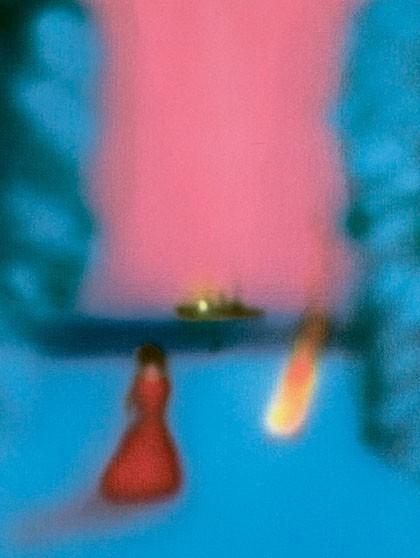
Unforeseen Seas
With the title Unpredicted Seas opens at the Portuguese Screen Printing Center on the 13th of February, an exhibition that presents the graphic work of three Masters of 20th century art in Portugal, Carlos Calvet, Noronha da Costa and José of Guimarães.
The exhibition will be open. patent until March 17, 2007. Carlos Calvet: Mental Oceans Carlos Calvet, architect, filmmaker, painter, is in Portuguese modern art, a fundamental reference. The artist was born in 1928 in Lisbon. He graduated in architecture from E.S.B.A.L., which did not stop him from dedicating himself to architecture from an early age. painting. José Augusto França emphasizes the constructivism of its compartmentalized surfaces and the muted coloring that "further contributes to the definition of a lyricism with a melancholic content". But what really touches us in Calvet's work is; the brilliance of its spaces where freedom radiates for a long time. It is very lost and where the energy and immensity of nature overlap with the ordered chaos of expanding forms, prefiguring the enigma of other universes. During the 1950s, when more or less opposing trends were fighting: neo-realism of a political and revolutionary nature, surrealism that was equally revolutionary but on an aesthetic level and the emerging abstraction; o, revealed at the Salon of 1954, Calvet knew how to choose the path of perfect and integral authenticity, on a "Journey to the Arcana of the Night", or to the abyssal depths of his unconscious, until the end of his life. today never interrupted. Carlos Calvet's seas tell us about a paradoxical solitude that desires the other and only wants to be the other. in the other, he fulfills his destiny of loving complicity with the mystery of the world, a way of peering into reality to better feel the unreal heart that beats in his breast. The artist, audacious navigator, "naut of the impossible" guides our steps on the maritime horizons of all miracles. The Planeta Guimar´es The work of José de Guimarães (who was born in 1939), in the various expressions he assumes, painting, engraving, sculpture, assemblage is the essence of his work. Before another language, the planet Guimarães (Gilbert Lascault) its repertoire of symbols and living signs invades everyday life translating its roots in a miscegenation of cultures that the artist assumes and considers a fundamental objective. His art is defined by the game, a game that is It is the very essence of art. Game and metamorphosis, liberation from the categories of time space, creation of a code of symbols of multiple referents. The invention of plastic writing guides the entire journey of the artist, who since the 70s and as a result of a stay in Africa (1967-1974), has been inspired by pictographic writings primitives. This language develops in series, each of them integrating new elements, according to a hidden logic and order, defined by the whole and always leaving traces, in an assumed dialectic between painting and sculpture. An aesthetics of fragmentation is emerging. Present in his painting from the 70s and 80s, this fragmentation is associated with the valorization of primary colors and chromatic planes that sometimes overlap in games of transparencies , cutting out a space without depth, which allows the human figure (and its doubles) to be highlighted, a central motif in the artist's work. Eroticism, his games, runs throughout Guimarães' work, giving it an atmosphere that sometimes involves a certain dramatism. The intimate engravings that we present today reveal the essential processes of the author's aesthetics, small friezes of an eroticism fueled by adventure and the pleasure of a journey through the oceans of secrets and wonders of a planet that dazzles us with its fauna and its flora, with figures of a sensuality that is It is the emblem of the spirit of these forms, translating the thirst for knowledge and joy, life's deepest legacy. Noronha da Costa: Landscapes of the Soul A large exhibition of recent paintings by Noronha da Costa at Galeria António Prates in Lisbon, once again drew attention to the importance of one of the most interesting routes of the second half of the 20th century in Portugal. The artist was born in 1942 in Lisbon. Painter, filmmaker and architect, he is graduated from the Escola Superior de Belas Artes de Lisboa. It has been developing an aesthetic centered on the problematic of the image that has already been created. This is present in his first works, collages in which he explored double and ambiguous images. An incursion into the poetics of objects that constructed an indefinite and surrealizing space would continue in his painting, which José Augusto França defines it as a "neo-romantic situation that goes to the ghostly sources of surrealism (...) and constitutes an "unrealization of the real" of deep consciousness. modern ance". The modernity of Noronha da Costa is emerging. precisely in its ability to interrogate appearances, viewing the visible as the starting point of an intellectual, sensitive and dreamlike experience. The seas, the landscapes of Noronha da Costa blur the boundaries between visible and invisible, image and metaphor, they are not clear, which is important. Here the world results from a repetition, from a veil of mists that are the face of the enigma, from a journey that is always restarted and never completed. Microlandscapes of a lost harmony, full of promises of a dawn of the spirit, as it is It is about the life of the spirit that we are talking about, the spirit of forms, an uncertain flame, a vague and splendid sun raising its effulgent certainties that sparkle in the moment that the image makes it remain.